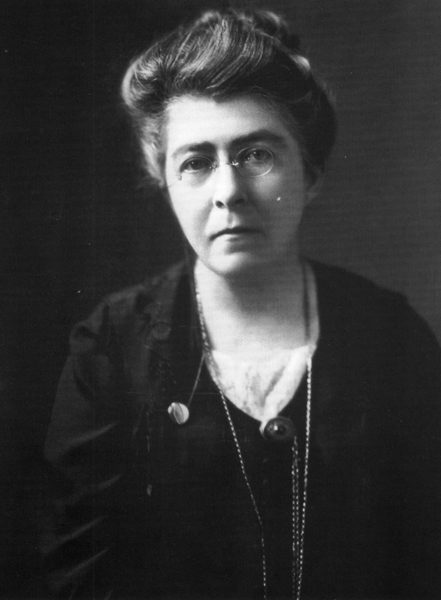20 April 1946: Johanna Mary "Hanna" Sheehy Skeffington Suffragette, Republican and political activist died on this day. She was born in 1877 in Kanturk Co Cork, the daughter of the future Nationalist MP David Sheehy &. Elizabeth "Bessie" McCoy. From an early age she was imbued with the spirit of political activity to free Ireland from British Rule and to improve the lot of women in Irish Society. Whilst still very young her family moved to Dublin.
When Hanna was a teenager, the Sheehys held an open house on the second Sunday night of each month. They encouraged young people to visit them and their six children. The Sheehys were fond of singing and playing games, and would ask their guests to sing. Hanna was sent to Germany for a short period when she was 18 years old to get treatment for tuberculosis. After graduating from the Royal University of Ireland, she moved to Paris to work as an Au Pair and returned to Ireland in 1902. She sat for examinations at Royal University of Ireland and received a Bachelor of Arts degree in 1899, and a Master of Arts Degree with first-class honours in 1902. This led to a career as a teacher in Eccles Street and an examiner in the Intermediate Certificate examination.
Hanna married Francis Skeffington on June 3, 1903 at University Chapel in St. Stephen's Green, Dublin. The couple wore their graduation gowns as a substitute for a traditional wedding gown and suit. Both husband and wife took the surname Sheehy Skeffington as a symbol of their honour for one another.
It was this point on that her political activity really took off as her husband was as a committed activist as she was. In 1908 she was a founder member of The Irish Women's Franchise League dedicated to ensuring Votes for Women in Parliamentary elections. On 13 June 1912, she, along with seven other women, were arrested for smashing the glass windows of Dublin Castle. They served a month long sentence in Mountjoy Prison alongside another month after they refused to pay a fine. They were granted the privileges of political prisoners. Sheehy Skeffington was fired in 1913 from her job as a teacher at Rathmines School of Commerce for her continued involvement in feminist militancy.
When the Great War broke out in 1914 she became involved in the anti-recruiting campaign and was prevented by the British government from attending a conference held in The Hague in April 1915 on Women’s Rights. The watershed in her life came during the Easter Rising 1916 when her husband Francis was brutally murdered by a deranged British Officer. She did not find out about his death until two days had passed.
She joined Sinn Fein in the aftermath of the Rising. In December 1916 she went to the US to raise awareness of Ireland’s Cause and she attended some 250 meetings there across America. She was later imprisoned by the British in Holloway Prison London for actively opposing the War. In 1920 she joined a Dublin corporation as a councillor. She resumed work on The Irish Citizen and in 1919 became organising secretary of Sinn Fein.
She opposed the Treaty in 1921 and again toured the USA in 1922 to raise funds to help Republican prisoners. In 1926 she joined Fianna Fáil as an executive, however she only kept this position for one year. She was disillusioned with the new Irish Free State and felt that women had not yet achieved their rightful place in Society especially in the new Irish Constitution of 1937. She stood for election to the Dáil in 1943 but was not returned.
Her daughter in law Andrée Sheehy-Skeffington (wife of her only son Owen Sheehy-Skeffington) recalled Hanna with great affection:
‘She was very helpful, but she could also be quietly critical. When I told her that I and some friends were forming the Irish Housewives Associations she said, “You’re not wedded to the house, you know!”’.
‘She was very fond of animals and also of flowers, particularly the orange lily. People used to raise an eyebrow at this, and she would say, “I will not allow Orangemen to have a monopoly of this beautiful flower!”’.
‘It was startling to see on her mantelpiece a photo of a British officer in uniform. This was Major Sir Francis Vane, who had ordered an enquiry into the murder of her husband. He did all he could to see that justice was done, and it cost him his position in the British Army’.
http://www.historyireland.com
‘She was very helpful, but she could also be quietly critical. When I told her that I and some friends were forming the Irish Housewives Associations she said, “You’re not wedded to the house, you know!”’.
‘She was very fond of animals and also of flowers, particularly the orange lily. People used to raise an eyebrow at this, and she would say, “I will not allow Orangemen to have a monopoly of this beautiful flower!”’.
‘It was startling to see on her mantelpiece a photo of a British officer in uniform. This was Major Sir Francis Vane, who had ordered an enquiry into the murder of her husband. He did all he could to see that justice was done, and it cost him his position in the British Army’.
http://www.historyireland.com
She died on 20 April 1946 and is buried alongside her husband in Glasnevin cemetery in Dublin.

No comments:
Post a Comment